Kinematic and Neuromuscular Ranges of External Loading in Professional Basketball Players during Competition
Abstract
:1. Introduction
2. Materials and Methods
2.1. Design
2.2. Participants
2.3. Sample
2.4. Variables
2.5. Equipment
2.6. Procedures
2.7. Statistical Analysis
3. Results
3.1. Speed Cluster
3.2. Acceleration and Deceleration Clusters
3.3. Impacts Cluster
3.4. Player Load/min Cluster
4. Discussion
5. Study Limitations
6. Conclusions and Practical Applications
- The traditionally established thresholds of kinematic variables, especially those referring to maximum intensity, do not really reflect the reality of competitive basketball. Therefore, it is necessary to establish new speed thresholds, based on the data obtained in competition, which allow a more concise customization of the different ranges of work, depending on the characteristics of each team (competitive level, sex, age) and each player.
- Since it is known that the competitive activity experienced by players is highly conditioned by different factors (gender, age, competitive level, etc.), future research on this topic could allow the establishment of speed ranges according to specific positions, gender, competition, etc., and thus, significantly improve the training processes.
- The high demands for accelerations and decelerations identified in these athletes suggest that specific lower-body strength training should be implemented to minimize the risk of injuries. Additionally, this strength training should be complemented with specific postural stability work for the lower limb joints.
- In any case, observing the results obtained under the perspective of maximum demand scenarios, it will be necessary to design tasks with a specific time frame that include high-intensity actions and/or sprints, together with accelerations and decelerations of moderate intensity, and high- and very-high-intensity. In the design of a task, the duration of time will be established, and it will be controlled so that the players reach those maximum physical demands, taking into account the reference values of each population of players, to guarantee adequate preparation for what they will have to face during the official competition.
- Coaches, when designing training sessions, and depending on their duration, should integrate the concept of maximum demand scenarios into the tasks, e.g., controlling the exposure time of a speed range within a time window, aiming to, during a defined time, reach the proposed speed peaks.
- The high level of neuromuscular load experienced by a basketball player during competition, both in relation to the impacts and the Player Load, makes it necessary to review the recovery protocols, as well as the distribution of the training contents, adapting the weekly microcycle of competition to this reality.
- Based on the different Player Load thresholds obtained and on the maximum demand scenarios, a weekly distribution of these scenarios could be established to provide the different types of stimuli throughout the competitive microcycle.
- The proposed Player Load thresholds should also be considered when designing recovery processes for sports injuries, and even establish them as indicators to consider a player fit or unfit to return to competition.
- The software linked to the inertial devices with which the data are recorded allows the customization of the working ranges for obtaining preliminary reports of the monitored training and competitions. These reference data can be used to customize the intensity ranges of the kinematic variables.
- As an example, the SVIVO application of the company Realtrack System (devices used in this research) allows a real-time visualization of the variables. Specifically, the Player Load information is displayed. Physical trainers can identify, during training and competition, when a player starts to be in a zone of high-intensity load (1.59 au/min), being a first referential approximation to identify the real load of a task or a moment of high physical demand during the competition.
Author Contributions
Funding
Institutional Review Board Statement
Informed Consent Statement
Data Availability Statement
Acknowledgments
Conflicts of Interest
References
- Roman, P.A.L.; Macias, F.J.V.; Pinillos, F.G. Effects of a contrast training programme on jumping, sprinting and agility performance of prepubertal basketball players. J. Sports Sci. 2018, 36, 802–808. [Google Scholar] [CrossRef]
- Schelling, X.; Torres, L. Accelerometer Load Profiles for Basketball-Specific Drills in Elite Players. J. Sports Sci. Med. 2016, 15, 585–591. [Google Scholar]
- Arede, J.; Ferreira, A.P.; Esteves, P.; Gonzalo-Skok, O.; Leite, N. Preparing for the youth basketball European Championship: Perceptual response and acute effects of an injury prevention program. Int. J. Sports Sci. Coach. 2022. [Google Scholar] [CrossRef]
- Khan, M.; Madden, K.; Burrus, M.T.; Sikka, R.; Bedi, A. Epidemiology and Impact on Performance of Lower Extremity Stress Injuries in Professional Basketball Players. Sports Health-A Multidiscip. Approach 2018, 10, 169–174. [Google Scholar] [CrossRef]
- Caparros, T.; Casals, M.; Solana, A.; Pena, J. Low External Workloads Are Related to Higher Injury Risk in Professional Male Basketball Games. J. Sports Sci. Med. 2018, 17, 289–297. [Google Scholar]
- Scanlan, A.T.; Tucker, P.S.; Dascombe, B.J.; Berkelmans, D.M.; Hiskens, M.I.; Dalbo, V.J. Fluctuations in activity demands across game quarters in professional and semiprofessional male basketball. J. Strength Cond. Res. 2015, 29, 3006–3015. [Google Scholar] [CrossRef]
- Gabbett, T.J.; Domrow, N. Relationships between training load, injury, and fitness in sub-elite collision sport athletes. J. Sports Sci. 2007, 25, 1507–1519. [Google Scholar] [CrossRef]
- Ibáñez, S.J.; Gómez-Carmona, C.D.; Mancha-Triguero, D. Individualization of Intensity Thresholds on External Workload Demands in Women’s Basketball by K-Means Clustering: Differences Based on the Competitive Level. Sensors 2022, 22, 324. [Google Scholar] [CrossRef]
- Reina, M.; García-Rubio, J.; Esteves, P.T.; Ibáñez, S.J. How external load of youth basketball players varies according to playing position, game period and playing time. Int. J. Perform. Anal. Sport 2020, 20, 917–930. [Google Scholar] [CrossRef]
- Salazar, H.; Castellano, J.; Svilar, L. Differences in External Load Variables Between Playing Positions in Elite Basketball Match-Play. J. Hum. Kinet. 2020, 75, 257–266. [Google Scholar] [CrossRef]
- Ibáñez, S.J.; Piñar, M.I.; García, D.; Mancha-Triguero, D. Physical Fitness as a Predictor of Performance during Competition in Professional Women’s Basketball Players. Int. J. Environ. Res. Public Health 2023, 20, 988. [Google Scholar] [CrossRef]
- Power, C.J.; Fox, J.L.; Dalbo, V.J.; Scanlan, A.T. External and Internal Load Variables Encountered During Training and Games in Female Basketball Players According to Playing Level and Playing Position: A Systematic Review. Sports Med.-Open 2022, 8, 107. [Google Scholar] [CrossRef]
- Reina, M.; Mancha-Triguero, D.; Ibáñez, S.J. Monitoring of a competitive microcycle in professional women’s basketball through inertial devices. Rev. Int. Med. Cienc. Act. Fis. Deporte 2022, 22, 663–685. [Google Scholar] [CrossRef]
- Reina, M.; García-Rubio, J.; Ibáñez, S.J. Training and Competition Load in Female Basketball: A Systematic Review. Int. J. Environ. Res. Public Health 2020, 17, 2639. [Google Scholar] [CrossRef]
- Scanlan, A.T.; Wen, N.; Tucker, P.S.; Dalbo, V.J. The relationships between internal and external training load models during basketball training. J. Strength Cond. Res. 2014, 28, 2397–2405. [Google Scholar] [CrossRef]
- Svilar, L.; Castellano, J.; Jukic, I. Load monitoring system in top-level basketball team: Relationship between external and internal training load. Kinesiology 2018, 50, 25–33. [Google Scholar] [CrossRef]
- Piedra, A.; Pena, J.; Caparros, T. Monitoring Training Loads in Basketball: A Narrative Review and Practical Guide for Coaches and Practitioners. Strength Cond. J. 2021, 43, 12–35. [Google Scholar] [CrossRef]
- Piñar, M.I.; García, D.; Mancha-Triguero, D.; Ibáñez, S.J. Effect of Situational and Individual Factors on Training Load and Game Performance in Liga Femenina 2 Basketball Female Players. Appl. Sci. 2022, 12, 7752. [Google Scholar] [CrossRef]
- Buchheit, M.; Lacome, M.; Cholley, Y.; Simpson, B. Neuromuscular Responses to Conditioned Soccer Sessions Assessed via GPS-Embedded Accelerometers: Insights Into Tactical Periodization. Int. J. Sports Physiol. Perform. 2018, 13, 577–583. [Google Scholar] [CrossRef]
- Portes, R.; Navarro, R.M.; Sosa, C.; Trapero, J.J.; Jimenez, S.L. Monitoring and Interpreting External Load in Basketball: A Narrative Review. Rev. Psicol. Deporte 2019, 28, 119–131. [Google Scholar]
- Stojanovic, E.; Stojiljkovic, N.; Scanlan, A.T.; Dalbo, V.J.; Berkelmans, D.M.; Milanovic, Z. The Activity Demands and Physiological Responses Encountered During Basketball Match-Play: A Systematic Review. Sports Med. 2018, 48, 111–135. [Google Scholar] [CrossRef]
- Varley, M.C.; Jaspers, A.; Helsen, W.F.; Malone, J.J. Methodological Considerations When Quantifying High-Intensity Efforts in Team Sport Using Global Positioning System Technology. Int. J. Sports Physiol. Perform. 2017, 12, 1059–1068. [Google Scholar] [CrossRef]
- Espasa-Labrador, J.; Fort-Vanmeerhaeghe, A.; Montalvo, A.M.M.; Carrasco-Marginet, M.; Irurtia, A.; Calleja-Gonzalez, J. Monitoring Internal Load in Women’s Basketball via Subjective and Device-Based Methods: A Systematic Review. Sensors 2023, 23, 4447. [Google Scholar] [CrossRef]
- Ibáñez, S.J.; Feu, S.; Cañadas, M. Integral analysis system of training tasks, SIATE, in invasion games. E-Balonmano.com 2016, 12, 3–30. [Google Scholar]
- Gómez-Carmona, C.D.; Bastida-Castillo, A.; Ibáñez, S.J.; Pino-Ortega, J. Accelerometry as a method for external workload monitoring in invasion team sports. A systematic review. PLoS ONE 2020, 15, e0236643. [Google Scholar]
- Ibáñez, S.; Antúnez, A.; Pino, J.; García-Rubio, J. Control del entrenamiento mediante el empleo de tecnologías en tiempo real en balonmano. In Avances Científicos para el Aprendizaje y Desarrollo del Balonmano; Feu, S., García-Rubio, J., Ibáñez, S., Eds.; Universidad de Extremadura: Cáceres, Spain, 2018; Volume Monografía 3, pp. 167–192. [Google Scholar]
- González-Espinosa, S.; Antúnez, A.; Feu, S.; Ibáñez, S.J. Monitoring the External and Internal Load Under 2 Teaching Methodologies. J. Strength Cond. Res. 2020, 34, 2920–2928. [Google Scholar] [CrossRef]
- García-Ceberino, J.M.; Antúnez, A.; Feu, S.; Ibáñez, S.J. Quantification of Internal and External Load in School Football According to Gender and Teaching Methodology. Int. J. Environ. Res. Public Health 2020, 17, 344. [Google Scholar] [CrossRef]
- Gamero, M.G.; García-Ceberino, J.M.; Ibáñez, S.J.; Feu, S. Influence of the Pedagogical Model and Experience on the Internal and External Task Load in School Basketball. Int. J. Environ. Res. Public Health 2021, 18, 11854. [Google Scholar] [CrossRef]
- Reina, M.; García-Rubio, J.; Ibáñez, S.J. Activity Demands and Speed Profile of Young Female Basketball Players Using Ultra-Wide Band Technology. Int. J. Environ. Res. Public Health 2020, 17, 1477. [Google Scholar] [CrossRef]
- Vázquez-Guerrero, J.; Fernández-Valdes, B.; Jones, B.; Moras, G.; Reche, X.; Sampaio, J. Changes in physical demands between game quarters of U18 elite official basketball games. PLoS ONE 2019, 14, e0221818. [Google Scholar] [CrossRef]
- Sosa, C.; Lorenzo, A.; Trapero, J.; Ribas, C.; Alonso, E.; Jimenez, S.L. Specific Absolute Velocity Thresholds during Male Basketball Games Using Local Positional System; Differences between Age Categories. Appl. Sci. 2021, 11, 4390. [Google Scholar] [CrossRef]
- Puente, C.; Abian-Vicen, J.; Areces, F.; Lopez, R.; Del Coso, J. Physical and Physiological Demands of Experienced Male Basketball Players During a Competitive Game. J. Strength Cond. Res. 2017, 31, 956–962. [Google Scholar] [CrossRef]
- Vázquez-Guerrero, J.; Reche, X.; Cos, F.; Casamichana, D.; Sampaio, J. Changes in External Load When Modifying Rules of 5-on-5 Scrimmage Situations in Elite Basketball. J. Strength Cond. Res. 2020, 34, 3217–3224. [Google Scholar] [CrossRef]
- Leicht, A.S.; Fox, J.; Connor, J.; Sargent, C.; Sinclair, W.; Stanton, R.; Scanlan, A. External Activity Demands Differ Between Referees and Players During a Sub-Elite, Men’s Basketball Match. Res. Q. Exerc. Sport 2019, 90, 720–725. [Google Scholar] [CrossRef]
- Ibáñez, S.J.; Feu, S.; Antúnez, A.; Arenas, M.A.; López, P. La investigación sobre baloncesto. Qué aporta el CIB y la Ciencia al Baloncesto. In Ciencia y Práctica en Baloncesto, una Relación de Presente y Futuro; Ibánez, S.J., García-Rubio, J., Eds.; Universidad de Extremadura: Cáceres, Spain, 2022; Volume 8, pp. 13–36. [Google Scholar]
- Houtmeyers, K.C.; Jaspers, A.; Figueiredo, P. Managing the Training Process in Elite Sports: From Descriptive to Prescriptive Data Analytics. Int. J. Sports Physioly Perform. 2021, 16, 1719–1723. [Google Scholar] [CrossRef]
- Aldenderfer, M.; Blashfield, R. Cluster Analysis; Sage Publications: Newbury Park, CA, USA, 1984. [Google Scholar]
- Ato, M.; Vallejo, G. Diseños de Investigación en Psicología; Ediciones Pirámide: Madrid, Spain, 2016. [Google Scholar]
- Montero, I.; Leon, O.G. A guide for naming research studies in Psychology. Int. J. Clin. Health Psychol. 2007, 7, 847–862. [Google Scholar]
- Pino-Ortega, J.; Bastida-Castillo, A.; Gomez-Carmona, C.D.; Rico-Gonzalez, M. Validity and reliability of an eight antennae ultra-wideband local positioning system to measure performance in an indoor environment. Sports Biomech. 2020; Online ahead of print. [Google Scholar] [CrossRef]
- Pérez-Chao, E.A.; Gómez, M.A.; Lisboa, P.; Trapero, J.; Jiménez, S.L.; Lorenzo, A. Fluctuations in External Peak Demands across Quarters during Basketball Games. Front. Physiol. 2022, 13, 868009. [Google Scholar] [CrossRef]
- Sweeting, A.J.; Cormack, S.J.; Morgan, S.; Aughey, R.J. When Is a Sprint a Sprint? A Review of the Analysis of Team-Sport Athlete Activity Profile. Front. Physiol. 2017, 8, 432. [Google Scholar] [CrossRef]
- Carling, C.; Le Gall, F.; Dupont, G. Analysis of repeated high-intensity running performance in professional soccer. J. Sports Sci. 2012, 30, 325–336. [Google Scholar] [CrossRef]
- Clarke, A.C.; Anson, J.; Pyne, D. Physiologically based GPS speed zones for evaluating running demands in Women’s Rugby Sevens. J. Sports Sci. 2015, 33, 1101–1108. [Google Scholar] [CrossRef]
- Kempton, T.; Sullivan, C.; Bilsborough, J.C.; Cordy, J.; Coutts, A.J. Match-to-match variation in physical activity and technical skill measures in professional Australian Football. J. Sci. Med. Sport 2015, 18, 109–113. [Google Scholar] [CrossRef]
- Varley, M.C.; Gabbett, T.; Aughey, R.J. Activity profiles of professional soccer, rugby league and Australian football match play. J. Sports Sci. 2014, 32, 1858–1866. [Google Scholar] [CrossRef]
- Delextrat, A.; Badiella, A.; Saavedra, V.; Matthew, D.; Schelling, X.; Torres-Ronda, L. Match activity demands of elite Spanish female basketball players by playing position. Int. J. Perform. Anal. Sport 2015, 15, 687–703. [Google Scholar] [CrossRef]
- Matthew, D.; Delextrat, A. Heart rate, blood lactate concentration, and time-motion analysis of female basketball players during competition. J. Sports Sci. 2009, 27, 813–821. [Google Scholar] [CrossRef]
- Scanlan, A.T.; Dascombe, B.J.; Reaburn, P.; Dalbo, V.J. The physiological and activity demands experienced by Australian female basketball players during competition. J. Sci. Med. Sport 2012, 15, 341–347. [Google Scholar] [CrossRef]
- Svilar, L.; Castellano, J.; Jukic, I. Comparison of 5vs5 training games and match-play using microsensor technology in elite basketball. J. Strength Cond. Res. 2019, 33, 1897–1903. [Google Scholar] [CrossRef]
- Vázquez-Guerrero, J.; Suárez-Arrones, L.; Gómez, D.C.; Rodas, G. Comparing external total load, acceleration and deceleration outputs in elite basketball players across positions during match play. Kinesiology 2018, 50, 228–234. [Google Scholar] [CrossRef]
- Petway, A.J.; Freitas, T.T.; Calleja-González, J.; Leal, D.M.; Alcaraz, P.E. Training load and match-play demands in basketball based on competition level: A systematic review. PLoS ONE 2020, 15, e0229212. [Google Scholar] [CrossRef]
- Reina, M.; García-Rubio, J.; Antúnez, A.; Ibáñez, S.J. Comparison of internal and external load in official 3 vs. 3 and 5 vs. 5 female basketball competitions. Retos 2020, 37, 400–405. [Google Scholar]
- Reina, M.; Mancha, D.; Feu, S.; Ibáñez, S.J. Is training carried out the same as competition? Analysis of load in women’s basketball. Rev. Psicol. Deporte 2017, 26 (Suppl. S1), 9–13. [Google Scholar]
- Fox, J.L.; O’Grady, C.J.; Scanlan, A.T. The Relationships Between External and Internal Workloads during Basketball Training and Games. Int. J. Sports Physiol. Perform. 2020, 15, 1081–1086. [Google Scholar] [CrossRef]
- Scanlan, A.T.; Fox, J.L.; Milanovic, Z.; Stojanovic, E.; Stanton, R.; Dalbo, V.J. Individualized and Fixed Thresholds to Demarcate PlayerLoad Intensity Zones Produce Different Outcomes. J. Strength Cond. Res. 2021, 35, 2046–2052. [Google Scholar] [CrossRef]
- Heishman, A.D.; Daub, B.D.; Miller, R.M.; Freitas, E.D.S.; Bemben, M.G. Monitoring External Training Loads and Neuromuscular Performance for Division I Basketball Players over the Preseason. J. Sports Sci. Med. 2020, 19, 204–212. [Google Scholar]
- Renshaw, I.; Davids, K.; Newcombe, D.; Roberts, W. The Constraints-Led Approach: Principles for Sports Coaching and Practice Design; Routledge: New York, NY, USA, 2019. [Google Scholar]
- Davis, A.C.; Emptage, N.P.; Pounds, D.; Woo, D.; Sallis, R.; Romero, M.G.; Sharp, A.L. The Effectiveness of Neuromuscular Warmups for Lower Extremity Injury Prevention in Basketball: A Systematic Review. Sports Med.-Open 2021, 7, 67. [Google Scholar] [CrossRef]
- Weiss, K.J.; Allen, S.V.; McGuigan, M.R.; Whatman, C.S. The Relationship Between Training Load and Injury in Men’s Professional Basketball. Int. J. Sports Physiol. Perform. 2017, 12, 1238–1242. [Google Scholar] [CrossRef]
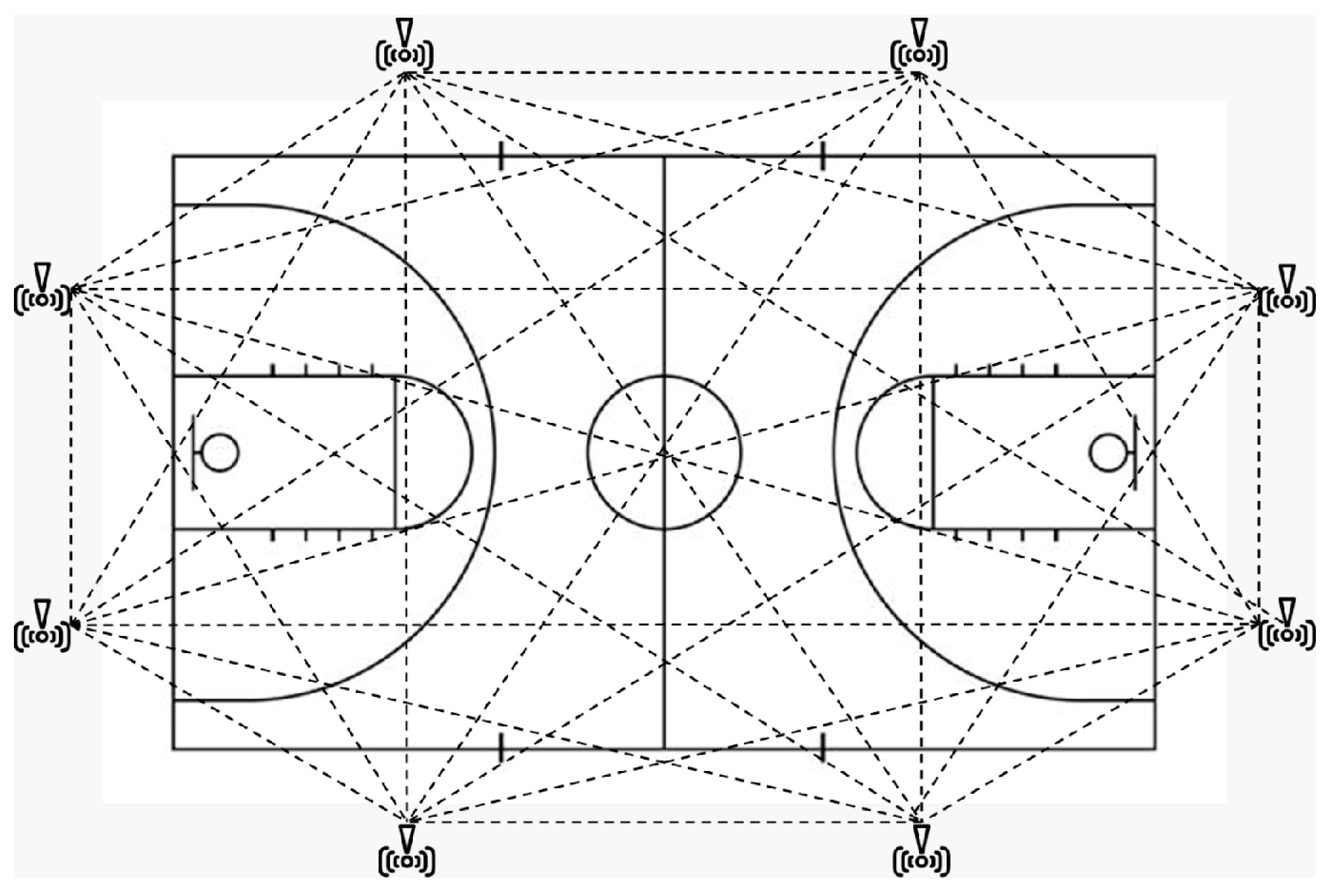
| Author | Sex | Level | Standing km/h | Walking km/h | Jogging km/h | Running km/h | Sprinting km/h |
|---|---|---|---|---|---|---|---|
| Reina et al. [30] | Female | U’18 | ≤3.6 | 3.6–6.5 | 6.5–10.2 | 6.5–10.2 | >14.4 |
| Vázquez-Guerrero et al. [31] | Male | U’18 | ≤6.0 | 6.0–12.0 | 12.1–18.0 | 18.1–24.0 | >24.1 |
| Sosa et al. [32] | Male | U’18 | <7.0 | 7.0–14.0 | 14.0–18.0 | ≥18.0 | |
| Puente et al. [33] | Male | Senior non-professional | ≤6.0 | 6.1–12.0 | 12.1–18.0 | 18.1–24.0 | ≥24.0 |
| Ibáñez et al. [8] | Female | Senior Professional and semi-professional | ≤2.31 | 2.31–5.33 | 5.34–9.32 | 9.33–13.12 | 13.13–17.08 |
| Scanlan et al. [6] * | Male | Senior Professional and semi-professional | ≤3.6 | 3.96–10.8 | 11.16–25.2 | >25.2 |
| Variable | Unit | Description |
|---|---|---|
| Speed | km/h | Space traveled in a unit of time |
| Accelerations | m/s2 | Positive speed variation |
| Decelerations | m/s2 | Negative speed variation |
| Impacts/min | Number of G-force impacts/min | Sum of impacts measured in G-forces supported by the athlete in the three planes per minute. |
| Player Load/min | arbitrary unit/min | Cumulative load resulting from acceleration in the 3 axes per minute |
| Speed (km/h) | Low/Walking | Moderate/Jogging | Very High/Sprinting |
|---|---|---|---|
| Cluster centers | 1.17 | 5.94 | 14.06 |
| Ranges | <3.51 | 3.52 to 10.62 | >10.63 |
| % | 57.9% | 33.0% | 9.1% |
| Distribution | 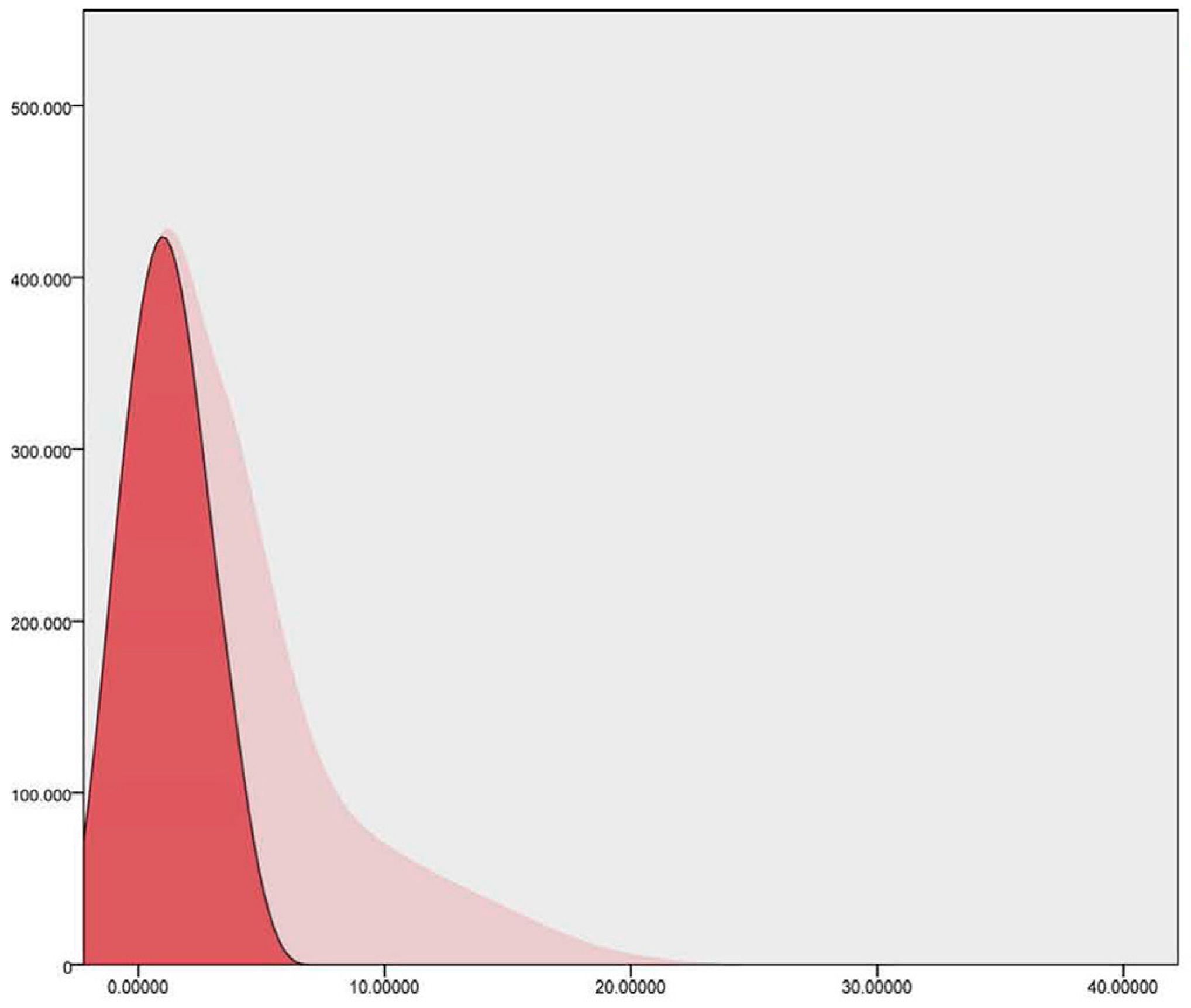 | 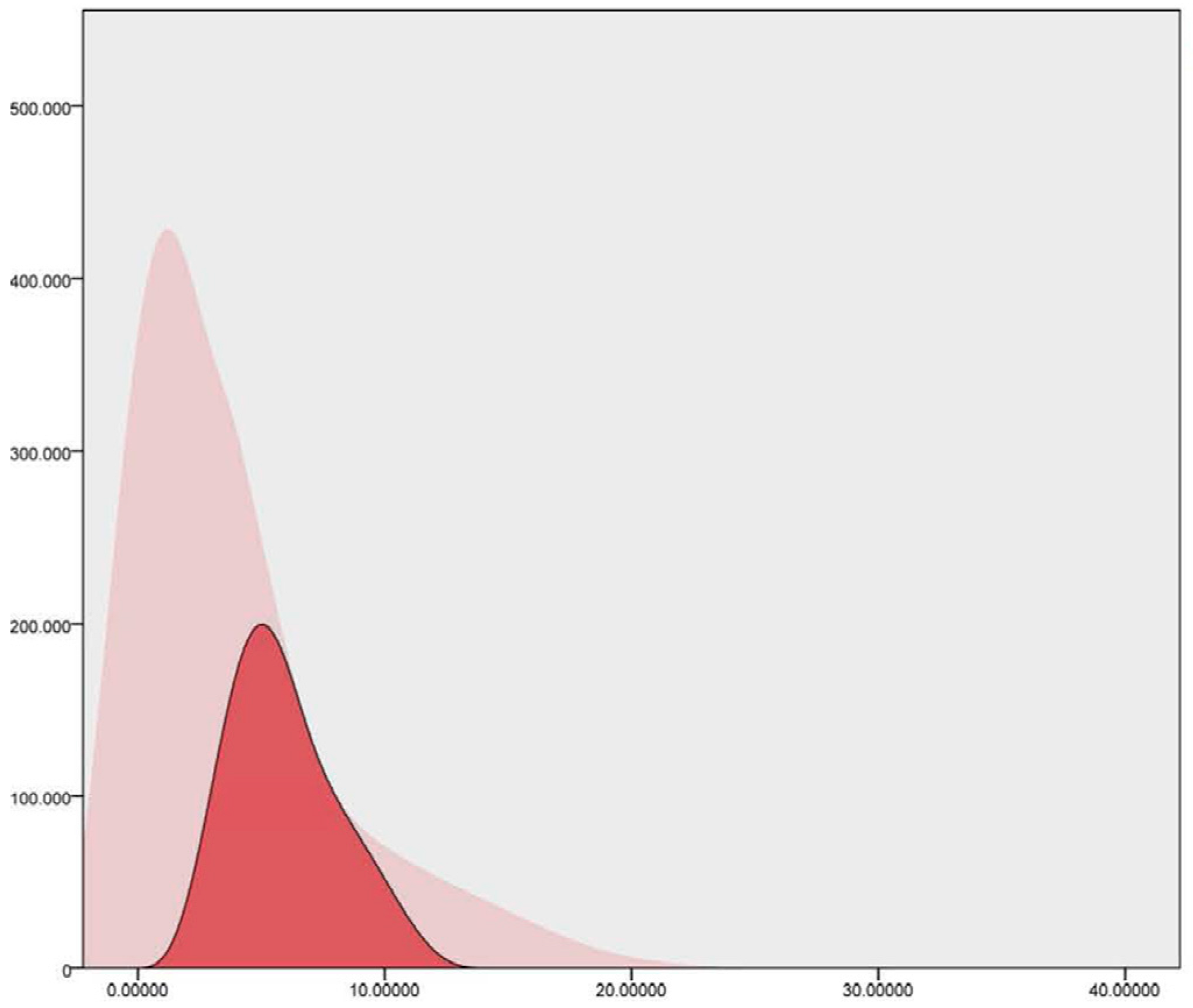 | 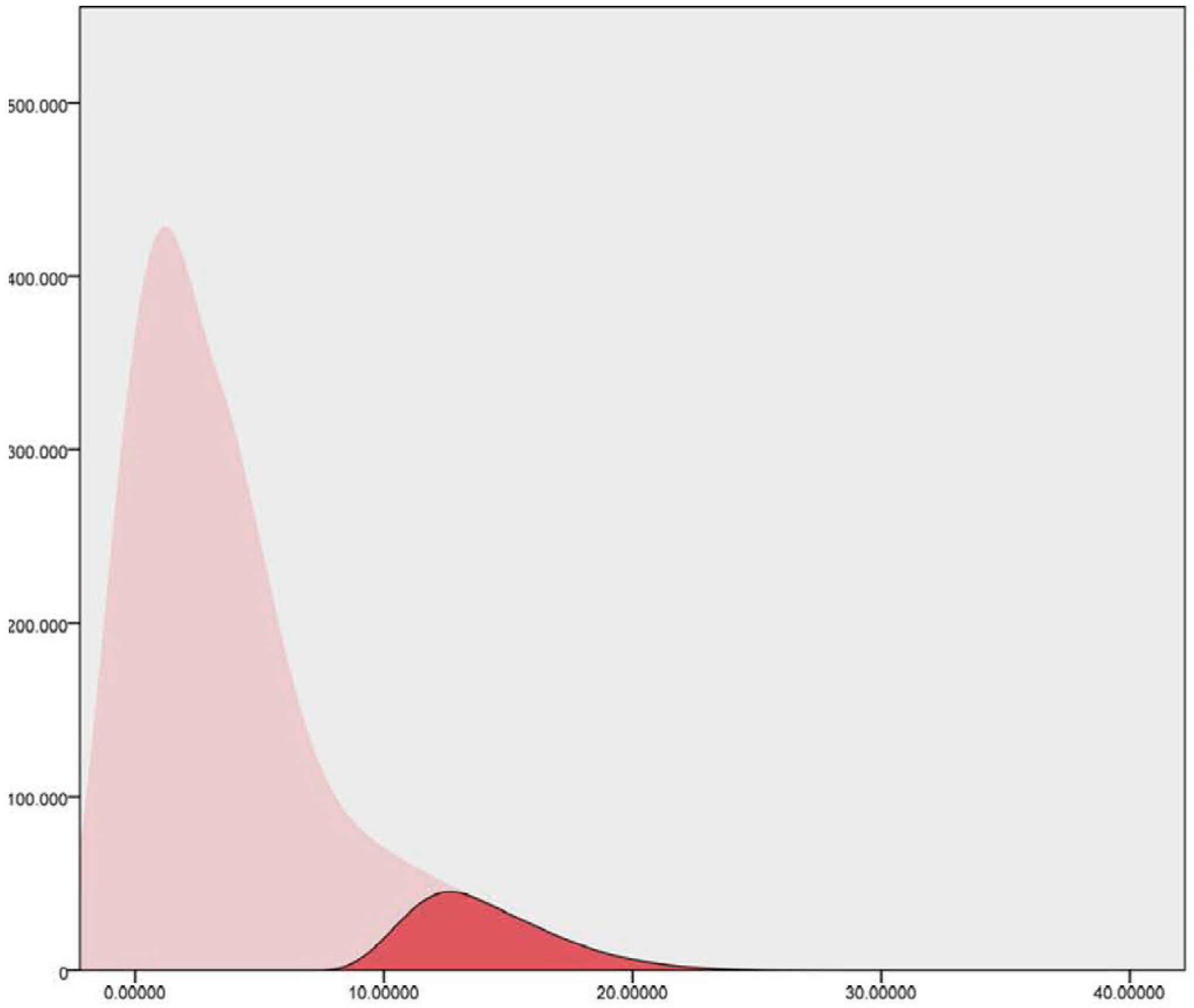 |
| Speed (km/h) | Very Low/Standing | Low/Walking | Moderate/Jogging | High/Running | Very High/Sprinting |
|---|---|---|---|---|---|
| Cluster centers | 0.92 | 4.73 | 9.85 | 14.70 | 19.35 |
| Ranges | <2.95 | 2.96 to 7.58 | 7.59 to 12.71 | 12.72 to 17.50 | >17.51 |
| n | 1,730,473 | 1,071,090 | 355,007 | 154,115 | 35,018 |
| Distribution |  | ||||
| ACCELERATIONS | |||
| Acc (m/s2) | Low | Moderate | Very High |
| Centers | 0.19 | 0.82 | 2.16 |
| Ranges | <0.45 | 0.49 to 1.42 | >1.43 |
| % | 43.1% | 51.7% | 5.2% |
| Distribution |  |  | 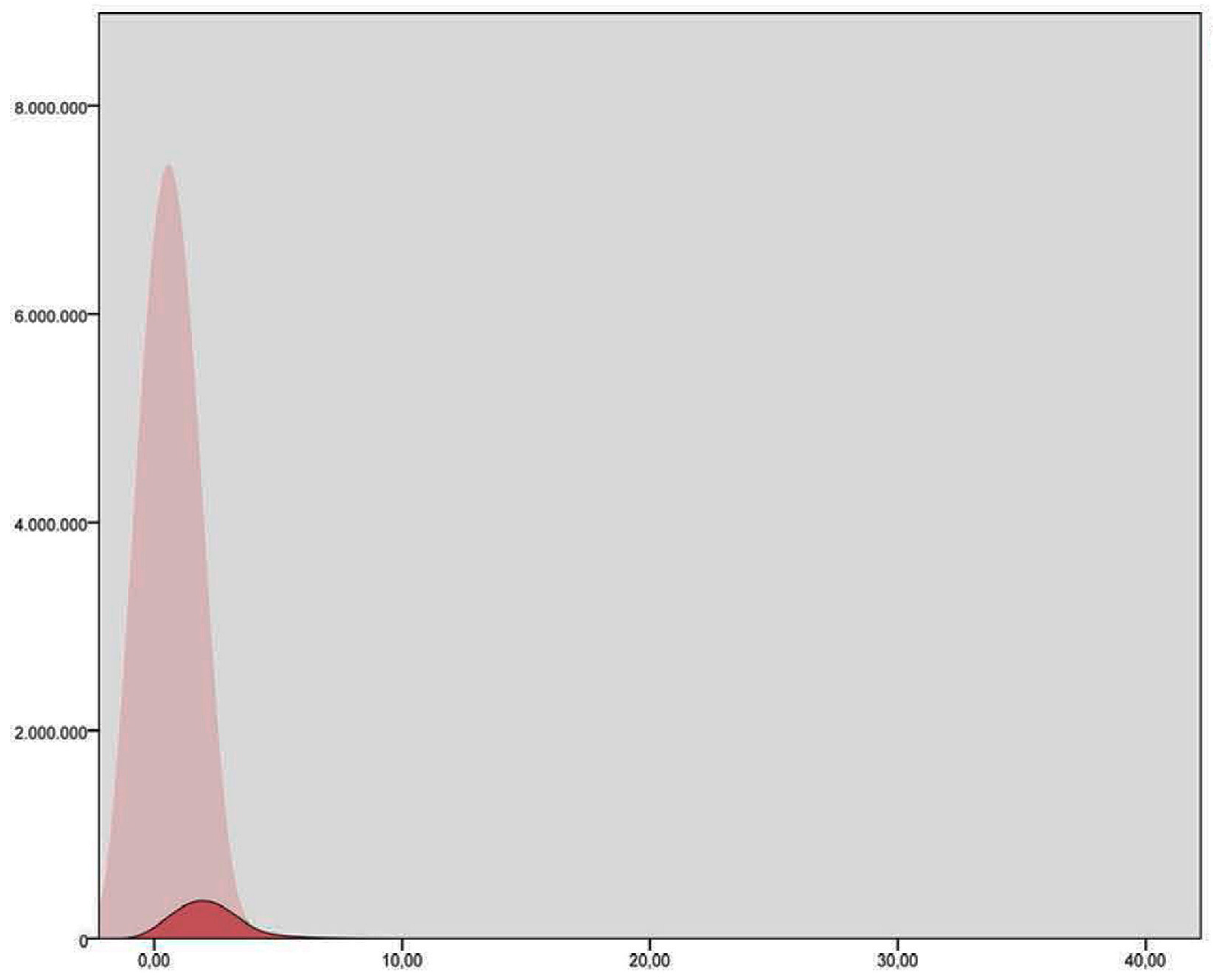 |
| DECELERATIONS | |||
| Dec (m/s2) | Low | Moderate | |
| Centers | −0.28 | −0.97 | |
| Ranges | −0.62 to 0.0 | −14.55 to −0.63 | |
| % | 69.5% | 30.5% | |
| Distribution | 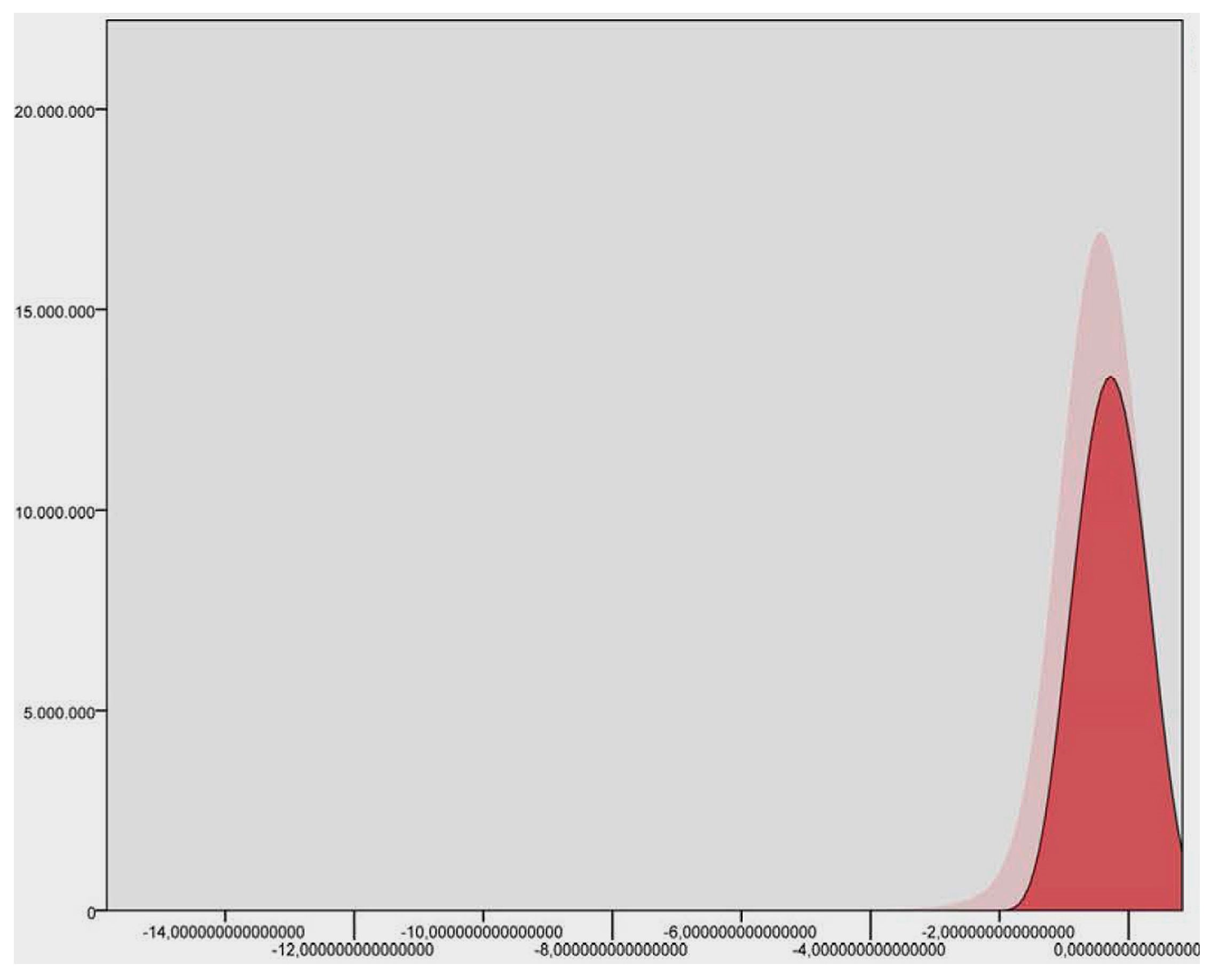 | 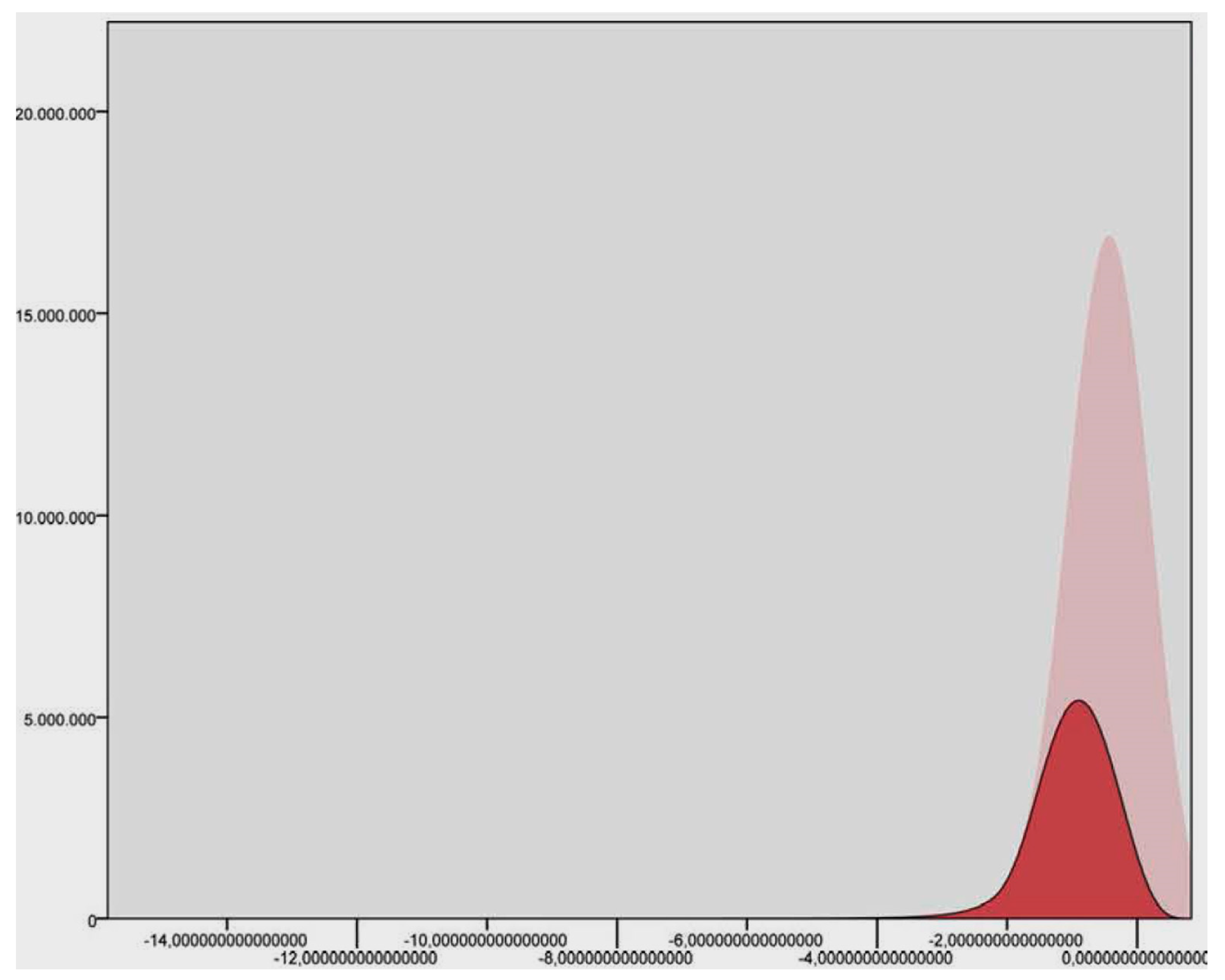 | |
| ACCELERATIONS | |||||
| Acc (m/s2) | Very Low | Low | Moderate | High | Very High |
| Centers (m/s2) | 0.46 | 1.29 | 3.34 | 6.49 | 14.23 |
| Ranges (m/s2) | <0.95 | 0.96 to 2.53 | 2.54 to 5.31 | 5.32 to 12.25 | >12.26 |
| n | 19,155,209 | 3,553,364 | 212,237 | 22,456 | 120 |
| Distribution | 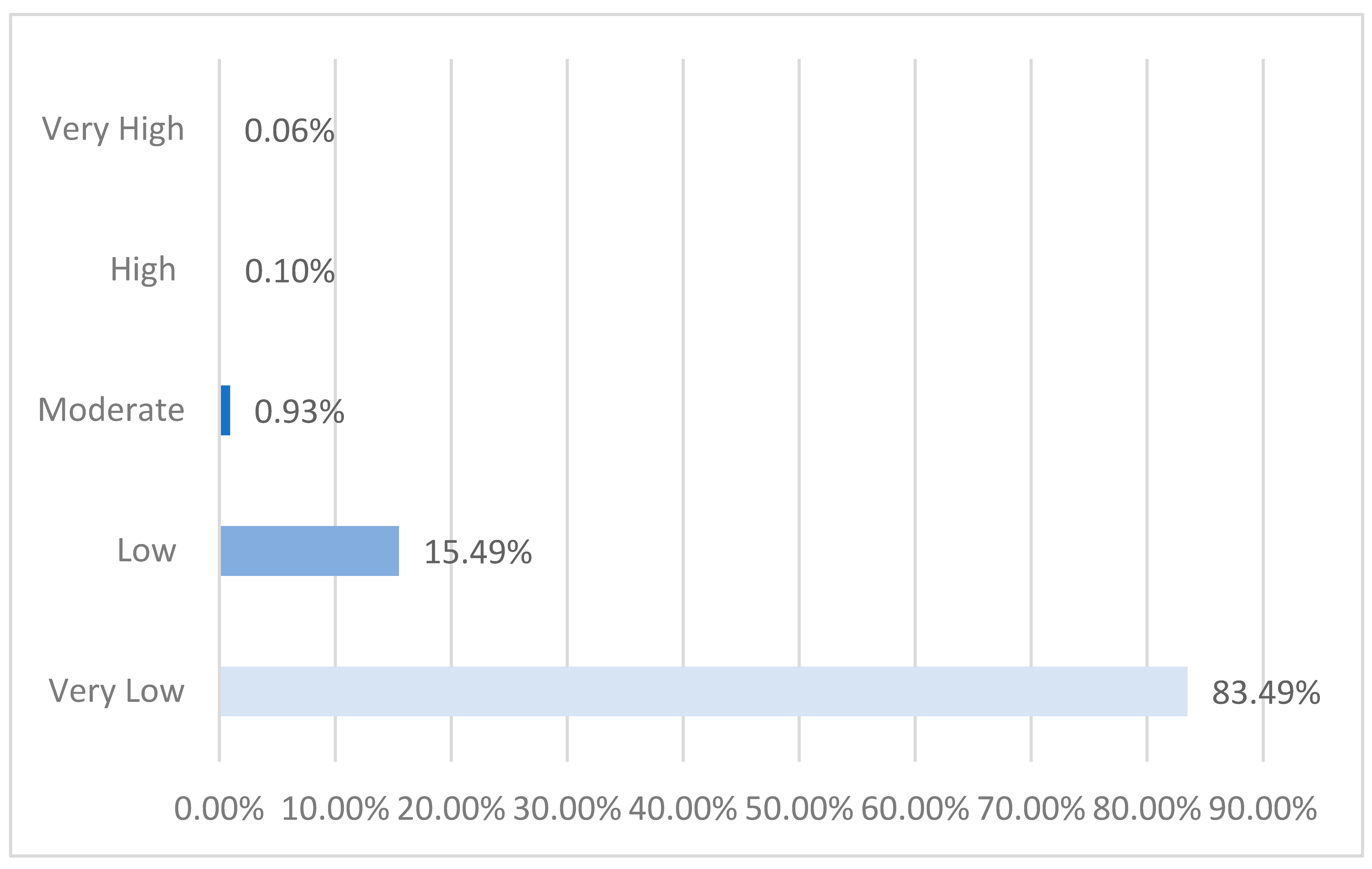 | ||||
| DECELERATIONS | |||||
| Dec (m/s2) | Very Low | Low | Moderate | High | Very High |
| Centers (m/s2) | −0.26 | −0.82 | −1.78 | −3.72 | −7.91 |
| Ranges (m/s2) | −0.56 to 0.0 | −1.37 to −0.57 | −2.98 to −1.38 | −6.27 to −2.99 | −14.55 to −6.28 |
| n | 17,019,957 | 8,571,962 | 812,185 | 45,195 | 1934 |
| Distribution | 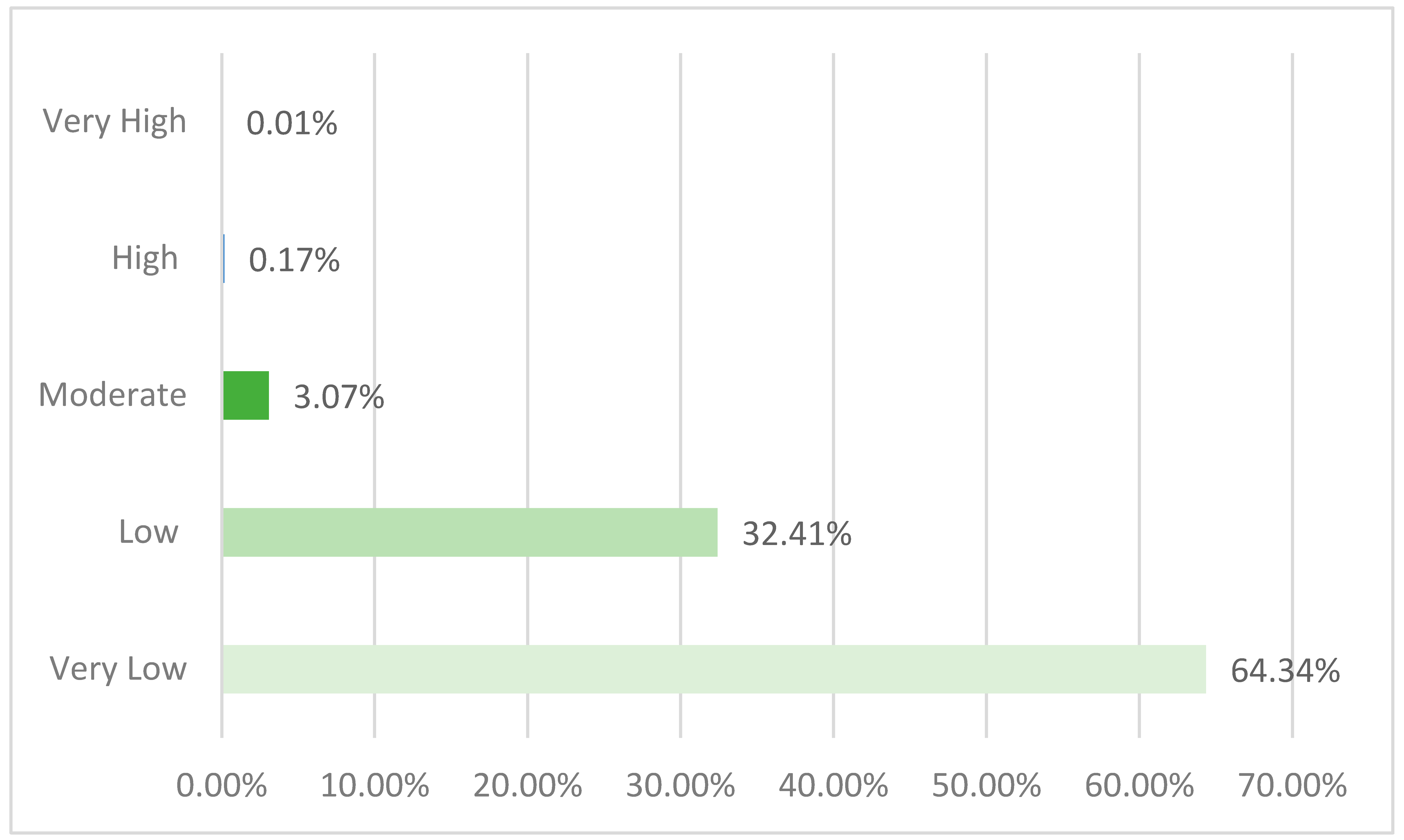 | ||||
| Impacts/min (G-force) | Moderate | High |
|---|---|---|
| Centers | 110.03 | 155.62 |
| Ranges | 27.50 to 130.75 | 131.00 to 223.47 |
| % | 40.1% | 59.9% |
| Distribution | 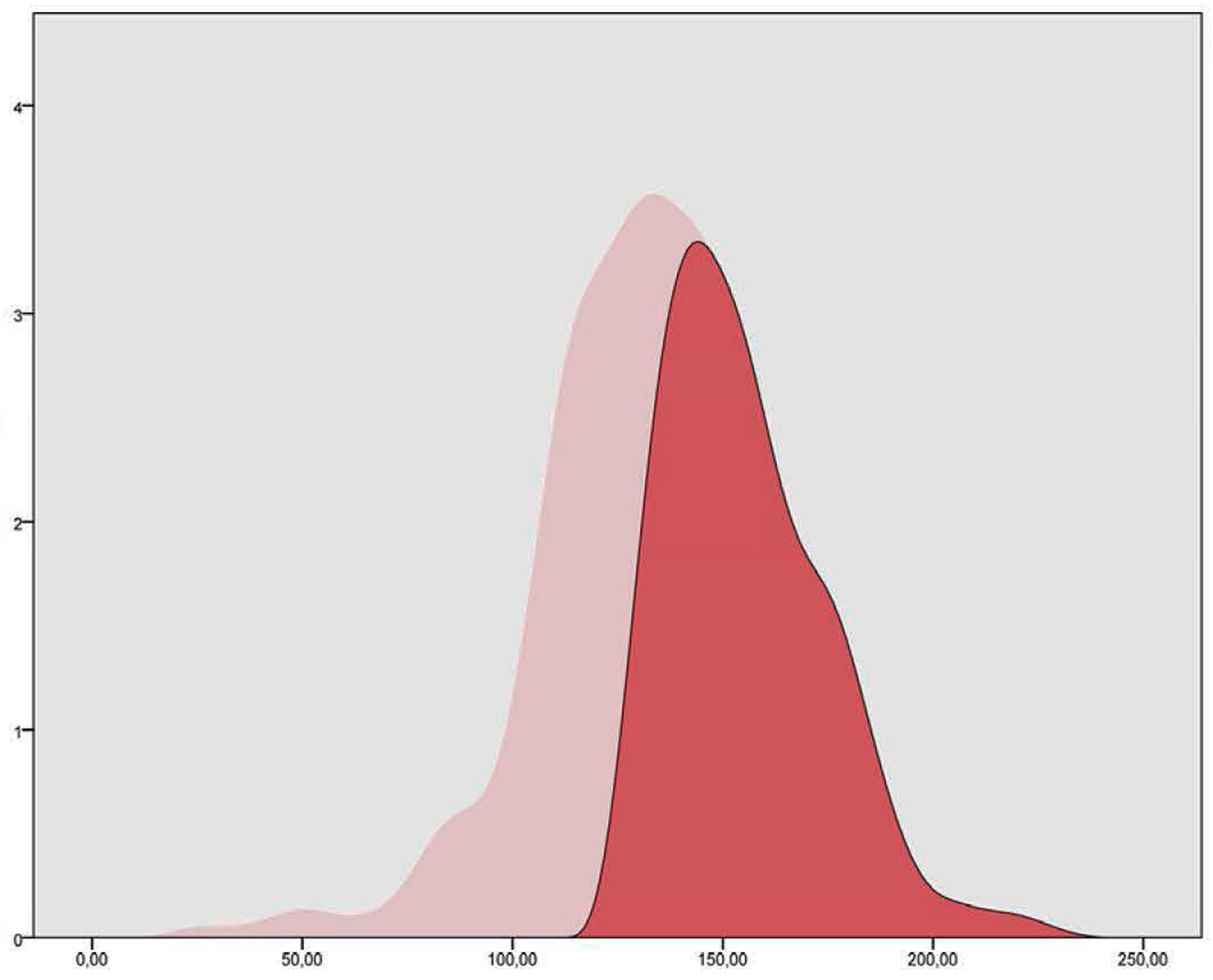 |  |
| IMP/min | Very Low | Low | Moderate | High | Very High |
|---|---|---|---|---|---|
| Centers | 57.45 | 107.40 | 132.01 | 155.10 | 182.69 |
| Ranges | 27.50 to 78.00 | 83.22 to 119.60 | 120.53 to 143.60 | 143.81 to 169.14 | 169.43 to 223.47 |
| n | 7 | 61 | 85 | 68 | 36 |
| Distribution |  | ||||
| PL/min | Very Low | Low | Moderate | High | Very High |
|---|---|---|---|---|---|
| Centers | 0.44 | 0.90 | 1.12 | 1.32 | 1.59 |
| Ranges | 0.19 to 0.64 | 0.65 to 1.01 | 1.02 to 1.21 | 1.22 to 1.43 | 1.44 to 1.93 |
| % | 2.7% | 26.5% | 32.3% | 25.7% | 12.8% |
| Distribution | 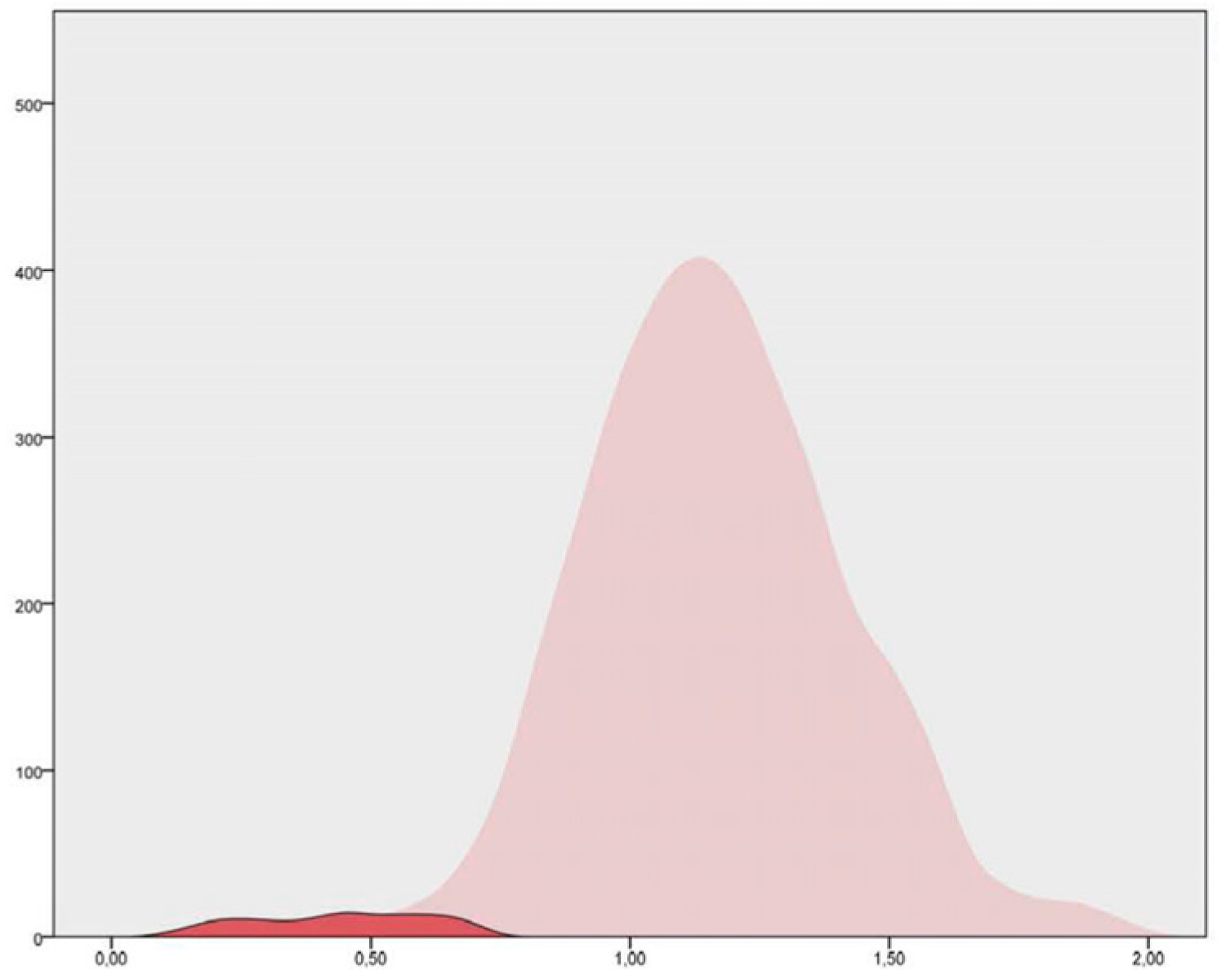 | 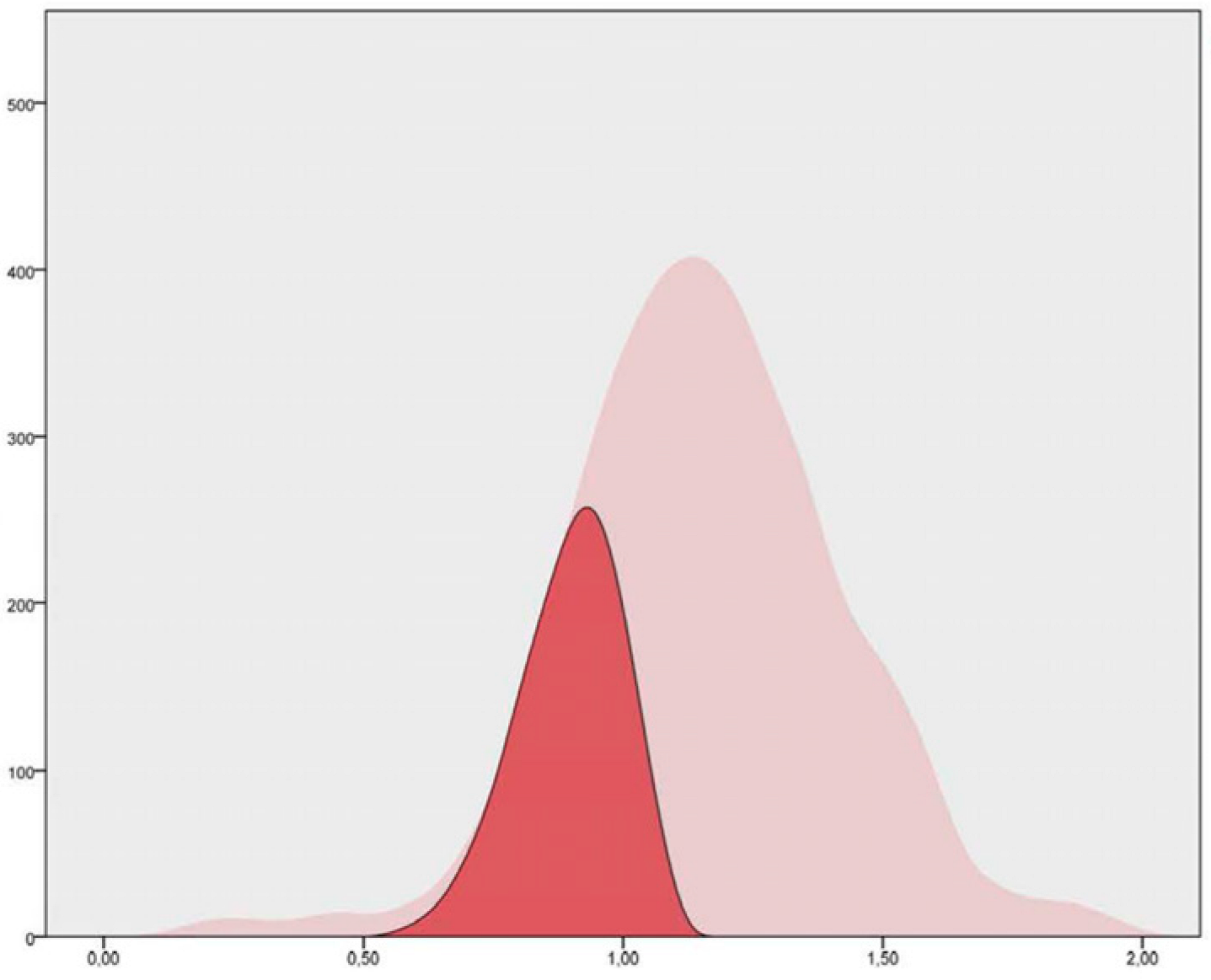 | 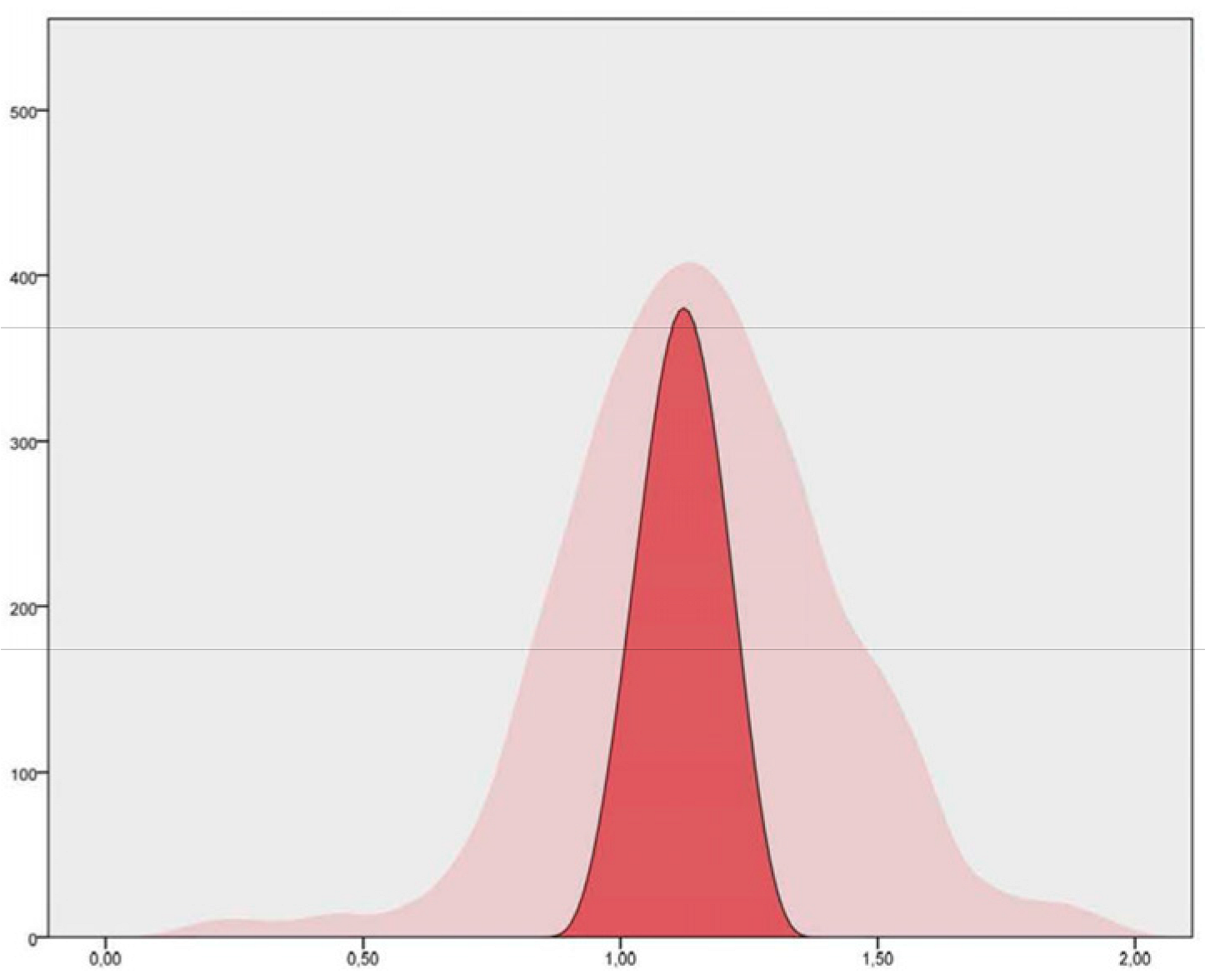 | 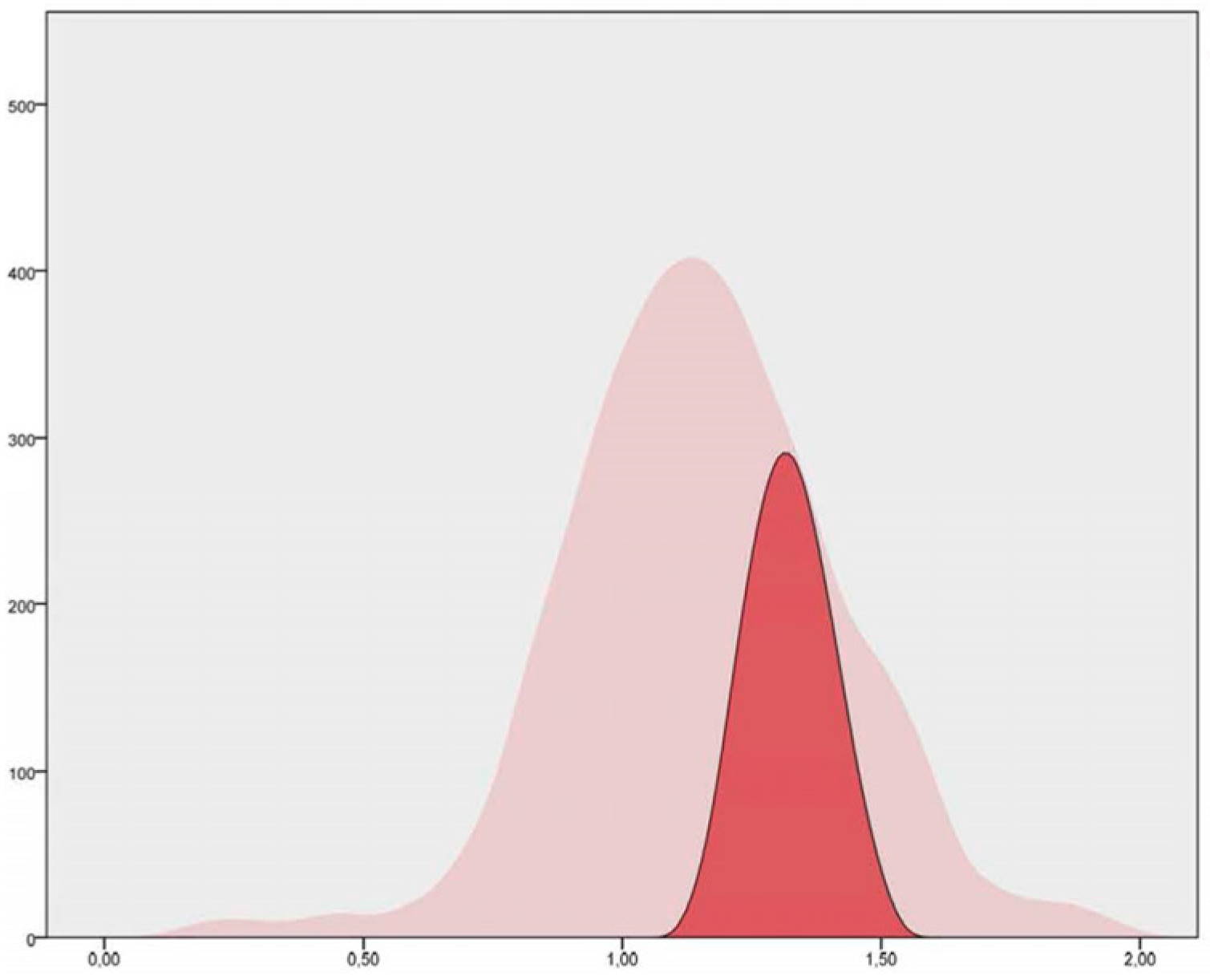 | 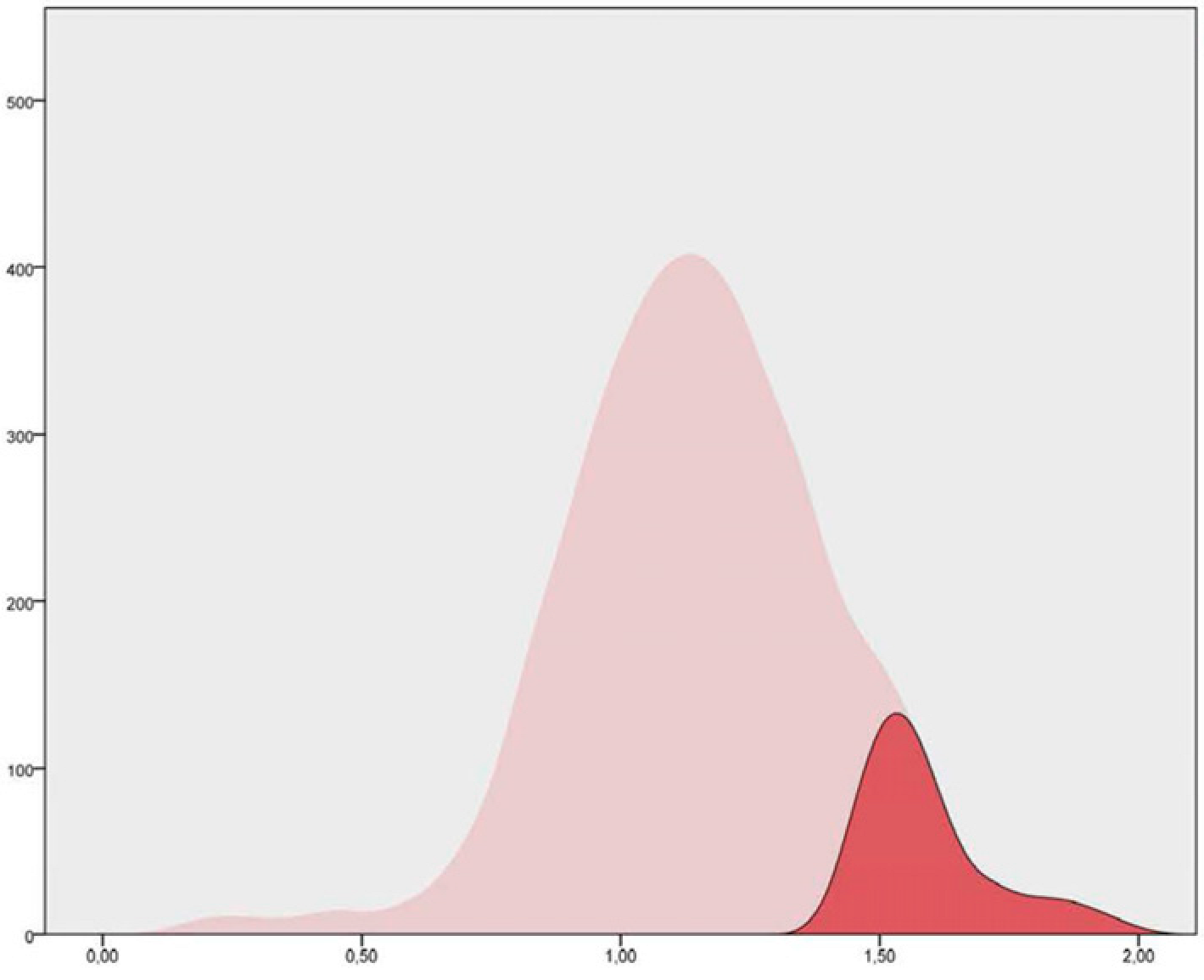 |
| PL/min | Very Low | Low | Moderate | High | Very High |
|---|---|---|---|---|---|
| Centers | 0.36 | 0.89 | 1.14 | 1.40 | 1.72 |
| Ranges | 0.19 to 0.50 | 0.51 to 1.01 | 1.02 to 1.27 | 1.28 to 1.56 | 1.57 to 1.93 |
| n | 5 | 70 | 101 | 69 | 12 |
| Distribution | 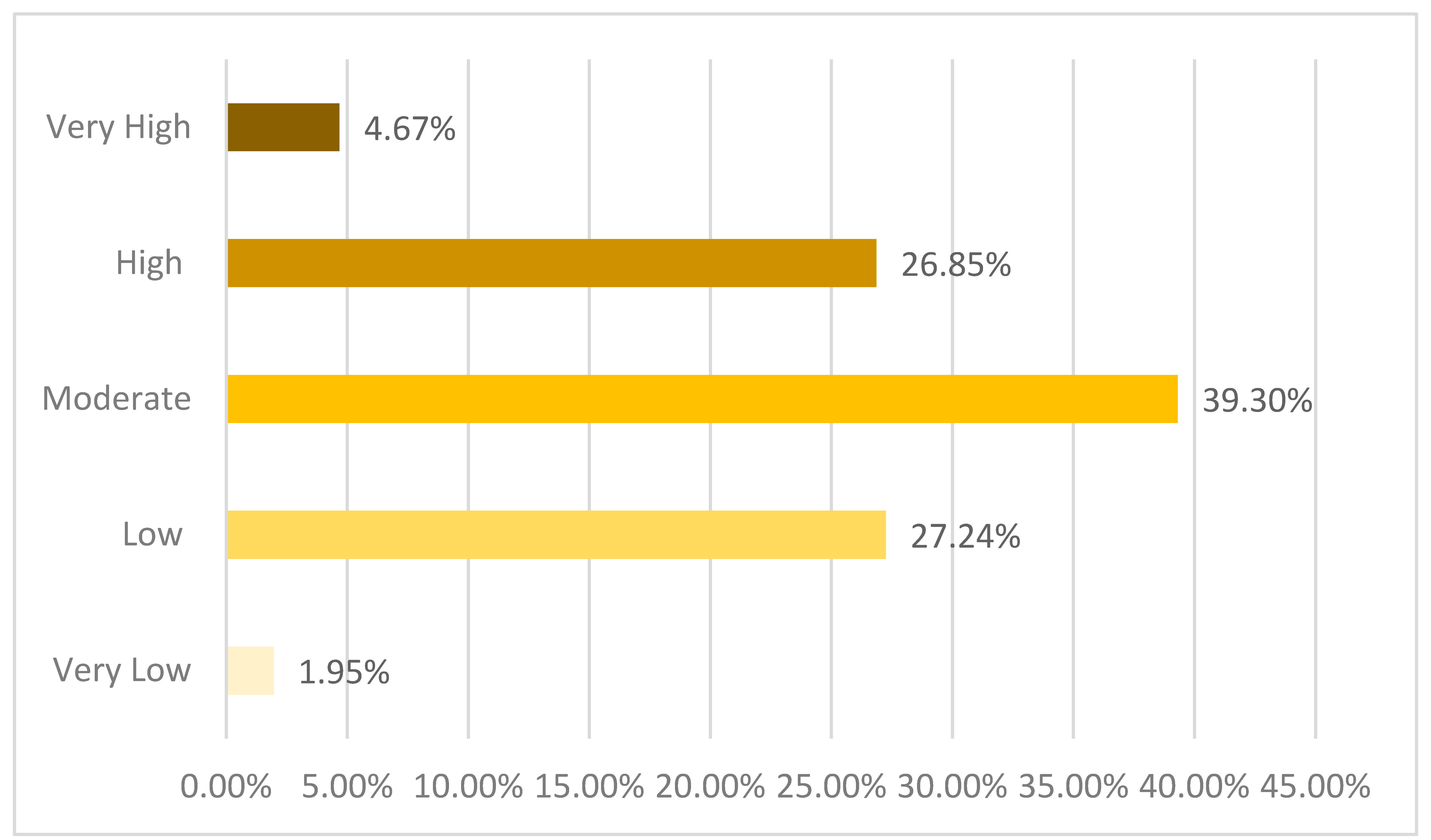 | ||||
Disclaimer/Publisher’s Note: The statements, opinions and data contained in all publications are solely those of the individual author(s) and contributor(s) and not of MDPI and/or the editor(s). MDPI and/or the editor(s) disclaim responsibility for any injury to people or property resulting from any ideas, methods, instructions or products referred to in the content. |
© 2023 by the authors. Licensee MDPI, Basel, Switzerland. This article is an open access article distributed under the terms and conditions of the Creative Commons Attribution (CC BY) license (https://creativecommons.org/licenses/by/4.0/).
Share and Cite
Ibáñez, S.J.; López-Sierra, P.; Lorenzo, A.; Feu, S. Kinematic and Neuromuscular Ranges of External Loading in Professional Basketball Players during Competition. Appl. Sci. 2023, 13, 11936. https://doi.org/10.3390/app132111936
Ibáñez SJ, López-Sierra P, Lorenzo A, Feu S. Kinematic and Neuromuscular Ranges of External Loading in Professional Basketball Players during Competition. Applied Sciences. 2023; 13(21):11936. https://doi.org/10.3390/app132111936
Chicago/Turabian StyleIbáñez, Sergio José, Pablo López-Sierra, Alberto Lorenzo, and Sebastián Feu. 2023. "Kinematic and Neuromuscular Ranges of External Loading in Professional Basketball Players during Competition" Applied Sciences 13, no. 21: 11936. https://doi.org/10.3390/app132111936









